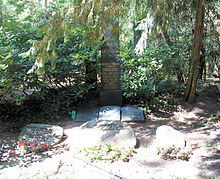Gallery Nierendorf
The Nierendorf Gallery is a traditional art gallery based in Berlin .
Act
Foundation and first years

The gallery with art trade was founded in 1920 by the brothers Karl (1889–1947) and Josef (1898–1949) Nierendorf in Cologne under the name Nierendorf Köln Neue Kunst . In 1925, Josef Nierendorf moved the gallery to Düsseldorf for a year . Karl Nierendorf had already taken over the graphic cabinet from I. B. Neumann in Berlin in 1923 and transformed it into the Neumann-Nierendorf Gallery in 1925 , which he and his brother Josef ran under this name from 1926, from 1933 as the Nierendorf Gallery . As in the Rhineland , the Nierendorf brothers also exhibited young expressionist art in Berlin , such as Otto Dix and the Brücke artists Erich Heckel , Emil Nolde and Karl Schmidt-Rottluff . Even unknown up-and-coming artists such as the student and later painter and art teacher Lorenz Humburg , Karl Blossfeldt or the neo-objective painter Ernst Thoms got a chance at Nierendorf. The gallery owners always saw themselves as patrons , sponsors and publicists for the artists they represented. 1934–1936 Nierendorf campaigned for the persecuted artists, particularly through the exhibition German Contemporary Art in 1935 ( Charles Crodel , Otto Dix, Karl Hofer and others).
From Berlin to New York
In 1936 Karl Nierendorf went to the USA and opened the Nierendorf Gallery in New York ; his brother continued to run the Berlin gallery alone until 1939. While Josef was drafted into the Wehrmacht and had to give up the business, Karl Nierendorf became an American citizen; he built his gallery in New York into a well-known address in the art scene, especially for artists who had emigrated from Germany.
After Karl Nierendorf's death in 1947 , the state of New York confiscated the entire estate under the pretext that the state of war between the USA and Germany was still ruling . A large part of the estate was sold to the Solomon R. Guggenheim Museum for a symbolic price , including over 100 works by Paul Klee . In 1949 Josef Nierendorf also died shortly before the reopening of his gallery in West Berlin.
New beginning in Berlin and the gallery today
Florian Karsch (1925–2015), stepson of Josef Nierendorf, and his wife Inge Karsch reopened the gallery in 1955 as Galerie Meta Nierendorf in a room in the bookshop of Josef Nierendorf's widow of the same name. In 1963 the gallery, art publisher and art dealer moved to Hardenbergstraße 19 in Berlin-Charlottenburg , where it still exists today as Galerie Nierendorf under the leadership of Ergün Özdemir-Karsch, Florian Karsch's adoptive son. The artists represented by the gallery include not only those mentioned above, but also representatives of Expressionism and Classical Modernism such as Ernst Barlach , Max Beckmann , Marc Chagall , Lovis Corinth , Gerhard Marcks , Otto Mueller , Hannah Höch and Christian Rohlfs , but also contemporary artists like Louise Christine Thiele . In 1995 the Karsch couple donated half of their collection to the Berlinische Galerie , including the graphic work by George Grosz .
Fonts
- Art papers from Galerie Nierendorf, Verlag Galerie Nierendorf
literature
- Anja Walter-Ris: The history of the Nierendorf gallery. Passion for art in the service of modernity. Berlin, New York 1920-1995. Free University, Berlin, dissertation, 2003.
- Yvonne Groß: Between Dix and Müller - The Berlin art dealer Florian Karsch and the Nierendorf Gallery, Berlin, Lexxion Verlagsgesellschaft, 2014.
Web links
- Website of the Nierendorf Gallery